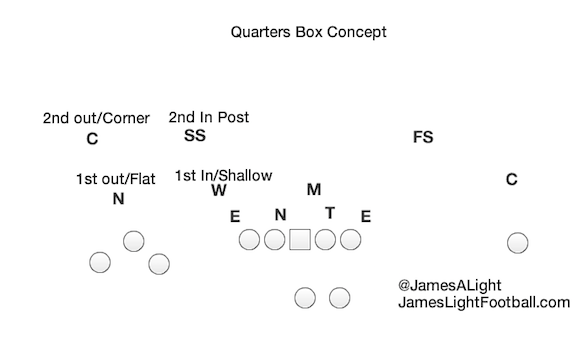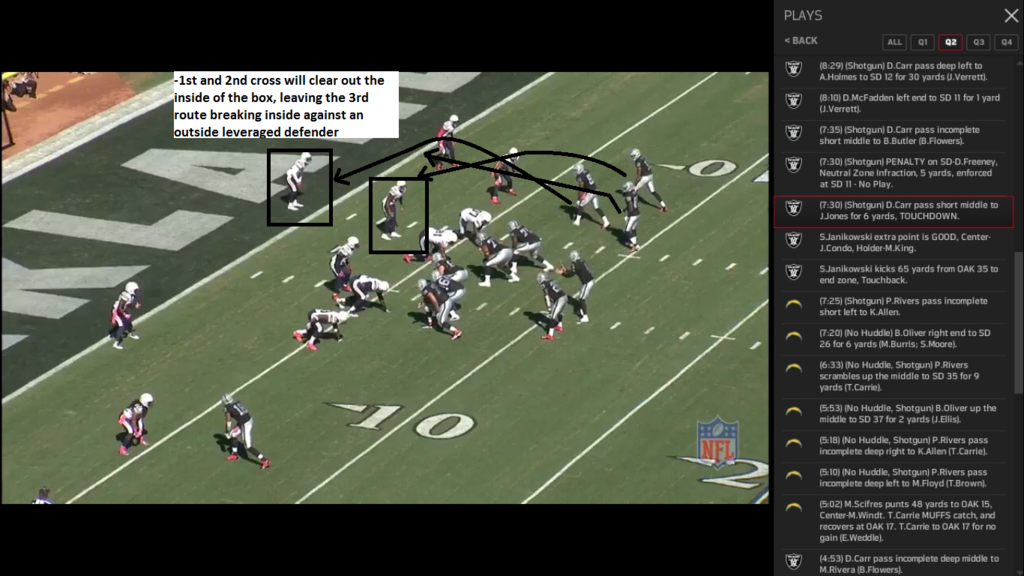Over the course of the 2014 season the Raiders often threw out of a “bunch” alignment in the read zone. I thought this play was interesting because it illustrates a very creative way to defeat a common Cover 4 (Quarters) “check” to a bunch formation, the “box” call.
A “box” call is a 4 over 3 coverage. The “box” check is a pattern-matching zone in which each defender begins the play with a zone that converts to man as the WR’s distribute. The DB’s must read the WR’s release at the LOS and decide if they are releasing inside/outside, and man-it from there.
Here is good illustration of the “box” alignment from JamesLightFootball.com (Jim’s site is a “must check” every day for my fellow film junkies):

If an offensive player doesn’t enter the defender’s zone, he will “zone off” and look to bracket anything close.
And here’s how the coverage plays out against the popular “Snag” concept:

On to the play…

The Original Formation….

-The O is showing twin WR’s to both side of the formation (Quads). Both slots and the “Z” are aligned with reduced, or tight splits to the core of the formation. This is often a key to a crossing route as the reduced split lets the WR get across the formation quicker.
-The WR’s to the field (wide) side are aligned in a “stack” look. Stack alignments are great for running short rub routes to pick defenders, particularly near the the goal line (like Seattle attempted in the Super Bowl). Notice the DB’s alignments. They are in a “levels” position, with a point man over the “On” WR and a CB aligned 2 yards out and 2 yards up. This alignment will allow the defenders to avoid picking each other as the routes distribute. The defenders could be playing straight man, but are most likely playing a “banjo” technique (I’ve got first inside route, you’ve got first outside route).
-The defense is most likely in man here. It is REALLY tough to play zone near the goal line as defenders have little time to react to a WR entering their zone. You have to press and open the hips if the WR crosses the goal line (NEVER EVER EVER backpedal into the end zone…it blows my mind how often I see NFL DB’s do this).
Motion to the Bunch….

-The weak slot is motioned across the formation to create the bunch. The DB “travels” with him across the formation, indicating man coverage.
-Notice that the SAM is checking to the box call. My guess is the Raiders offensive staff picked up this red zone tendency by the defense on film and designed this roue combo for this exact situation. I have 2-3 “box” beaters in my back pocket, but I have never seen this combo before. I’d really like to know if it was created in house or if the coaching staff picked it up somewhere else.
The Bunch…

-The motioned-slot has paused just inside the #2 WR, creating the bunch look. Notice that the CB, SS, MIKE, and SAM have all adjusted their alignment to “catch” the WR’s as they release. Now you see where the coverage call comes from, a box ![]()
-Because this is a Cover 4 check, the defense is in split safety coverage, or MOFO (Middle of the Field Open). Notice the alignment by the boundary CB at the bottom of the screen. When playing press near the goal line, the general technique is to align with inside leverage over the WR (the defender will split the WR’s crotch with his outside foot) to prevent the slant. The CB will have to rely on his reactions to play the fade, but if he gives up the slant he will not stop it. In this case because the CB has help inside from the FS, he will align with outside leverage to funnel the WR towards his help.
The Box…

-Each defender’s pass responsibility has been marked-up. Remember, if an offensive threat does not enter a defender’s area of responsibility he will zone up. Like the “triangle” call, the defenders are reading the WR’s route stem and matching accordingly. The box call will pattern match most common route concepts easily if each defender makes the correct read.
The Routes….

-The concept to defeat the box is very simple. Remove the 1st and 2nd “inside” defenders with crossing routes, then fake the flat route and break straight to the vacated area with WR #3. This route combo works for two reasons:
1. The concept conflict the defender’s rules by forcing the “1st out” defender to play an inside-breaking route from outside leverage, creating immediate separation. Everything happens so fast near the goal line that any competent QB/WR won’t need much separation to hit this play.
2. You don’t often see a 3 man route concept (aside from vertical routes like 4 verts and switch) that doesn’t include a flat route. When the #1 and #2 WR stem past the 1st out/flat defender, he will likely expect a flat route. 3 inside-breaking routes from trips is VERY rare because the 3 WR’s condense the field, creating spacing issues.
The routes are:
-a 2 yard shallow by the #1 WR
-a 4-yard shallow by the #2 WR
-a head fake to the flat and straight to the hole created by the #1 and #2 WR. There is no name I know of for this route; the WR simply runs to open space
The Releases….

Matching the Patterns….

-You can see the 1st and 2nd “In” defenders manning the shallow routes.
-Because there is not threat to the corner, the 2nd “out” defender (the CB) will try to rob any route within reach.
-Notice the leverage of the 1st “out”/flat defender. He has to play outside-to-in against a WR who is bending away from him. He is already beat if the route and throw are adequate. He hasn’t blown a coverage or made a mistake. He’s a victim of creative play design.
Anticipating the Hole…

-The ball is almost out as the WR breaks towards the open hole. The QB knows the WR will work away from the defender’s leverage by bending the route inside. This isn’t a progression-based play with multiple reads. Go back to the film and watch the shallow crossers. After breaking inside, both create a pick by stopping the route in front of their defender.
If the D checks to the box then the ball is going to the #3 WR ever time as the play is designed to beat this specific coverage check. If the D didn’t appear to make the box check, there might have been a second pre-determined play to audible into.
-Great film work to pick up a red zone tendency and exploit it with creative play design. The most common “box” beater you will see is the “Sail” concept, a 3-man route concept that includes a 9 route, 10 yard speed out, and flat route from outside-to-in.
The 9 route clears the CB and the flat clears the SAM, leaving the SS to play the speed out (playing an outside-breaking route from inside leverage; again, immediate separation). “Sail” doesn’t work well in the red zone however, as there isn’t enough room to run the CB off. This play was certainly an interesting way of getting around that limitation.
